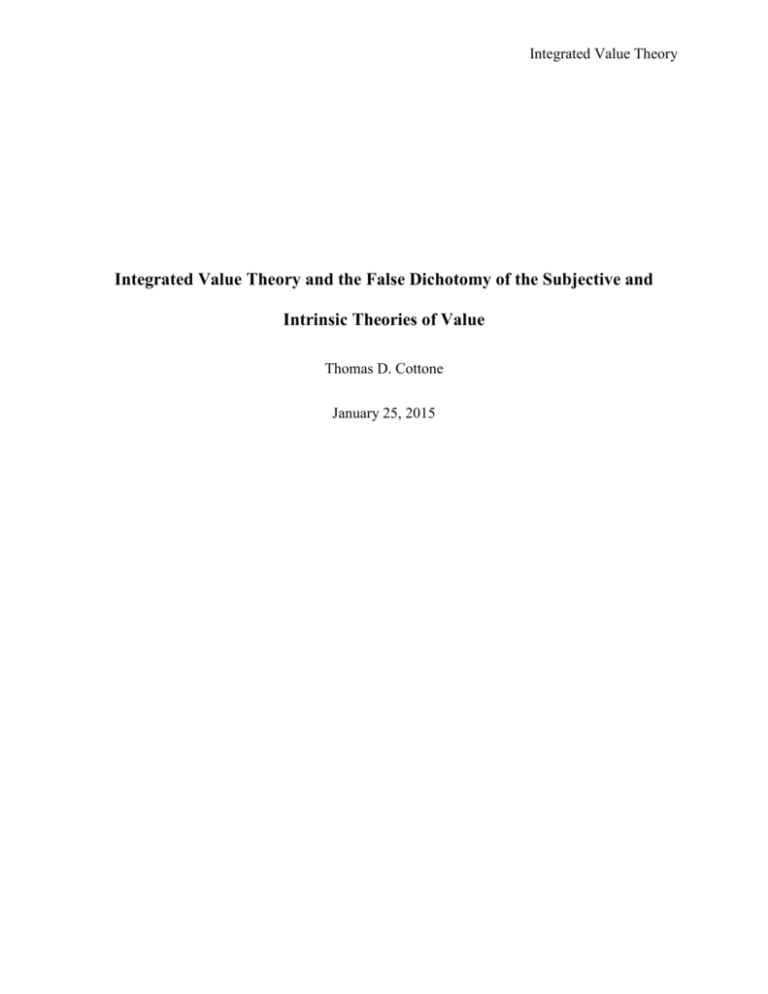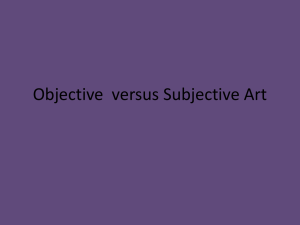Integrated Value Theory and the False Dichotomy of the Subjective
advertisement

Integrated Value Theory Integrated Value Theory and the False Dichotomy of the Subjective and Intrinsic Theories of Value Thomas D. Cottone January 25, 2015 Integrated Value Theory 1 Invariably, when a discussion of value theory occurs, it begins with “you have this product.” The problem with this is that it ignores the entire process that led to the existence of that product. Here I am not talking about the cost of production, but instead to the reasons for its production. It is also at this point that the two dominant theories of value, subjective and intrinsic, collide. This decades long debate though, is based on a false belief that the two theories are mutually exclusive. Now, obviously, many of the concepts of each theory are contradictory to each other. However, it is the base premise of each theory that is the problem. They are arguing over two different concepts. Subjective value is the motivation for economic activity, while intrinsic value is an artifact of economic activity. The mistake intrinsic value theorists make is in trying to look at intrinsic value as the final “price” or value of an object instead of as the “cost” or accrued value of an item. Subjectivists poorly articulate the fluidity of value expressed in the idea of accrued value (though the idea becomes quite evident if one follows the logic of subjective value). This problem occurs quite often in economics whenever a snapshot is used to illustrate concepts instead of the scope of the process. The second major problem of both theories is that they try to create a single idea of value. What is more accurate would be to say there are different aspects of value and instead we should investigate the interactions of these aspects to determine how economic activity works. In integrated value theory, the different aspects of value are defined and their relationships established. The other part of integrated value theory is the idea that the dominance of the different aspects of value vary widely based on the type of industry the product comes from. For example, the reason intrinsic value theory holds so much sway currently is that for over a century now we have had a large, industrialized economy based on heavy manufacturing, thus cost of production is a large factor in the standardization of value. However, the shift to Integrated Value Theory 2 more financial and service based industries is bringing subjective value back into prominence as these products are usually priced by perceived values without any physical product to associate production costs with. Another factor is the size of the economy being examined. In large economies that are regulated by an extensive price system, intrinsic value is more dominant. In smaller economies, especially barter based, subjective value is dominant. Aspects of Value In Physics, the atom used to be considered the smallest component of matter, but with progress, we now know there are smaller components to the atom that more fully explain the interaction of matter. Value theory needs the same evolution. Value as a solitary concept is inadequate to the understanding of economic activity. It is only when value is broken down into different components that a fuller understanding of the process and motivations of economic activity can be understood. The basic assumption of integrated value theory is that the actors are rational. Rational being defined as prioritizing needs before wants and making exchanges to gain value. As far as free market is concerned, it will become self-evident that it will more fully and accurately express the different aspects of value than any controlled or regulated market will. The most precious commodity each of us has is time. Time, once used or even if we are inactive, is gone. The most basic aspect of value is Fundamental Value (FV). Essentially, FV is the amount of time a person is willing to sacrifice to obtain a product or service. FV is personal and subjective, but more importantly it is also transitory. The “value” we place on an object can change dramatically due to changes in our situation. Because of these factors, it is not a quantifiable value. FV is the driving force of economic activity and is the most in line with Integrated Value Theory 3 standard Subjectivist value theory. FV is the most dominant factor in small economies or in barter style exchanges. It is the primary reason that two parties can make an exchange and both gain value in the exchange. A subjective judgment of relative value is required for an exchange to occur. If two parties exchange three chickens for a sheep, the idea that those two commodities have some sort of equal objective value is problematic. Obviously one party believed that the sheep had more value than three chickens and the other party believed the opposite or the exchange would not have taken place. It is the fact that the two parties have different, subjective views on the relative worth of the two commodities that allows the transaction to occur. It is important to note the distinction of using time instead of labor as a basis for FV. While labor is the most common and obvious use of time to acquire the means to purchase a product, it is not exclusive. Adam Smith’s focus on labor is what opened the door to Marx’s criticism of Labor Theory. Marx’s premise that there can be no profit in a perfect market without the exploitation of labor is only made possible because of this exclusive focus on labor. The increased productivity and efficiency gained from specialization that Smith points to do not fully explain how profit is generated. Marx’s contention that this makes the labor of the specialist more valuable has merit in this case. However, what Marx fails to account for (and Smith to some extent) is that profit comes mainly from the purchaser’s decision to save “time”. To make a car from scratch would take an individual at least a few years (if it was even possible) to acquire the knowledge, tools and means. However, by expending just six months’ worth of labor, the individual can instead buy one. This is obviously better for the purchaser. The manufacturer, using mass production and specialized labor can make the car far faster and of better quality. Viewed from this perspective, the fallacy of Marx’s critique becomes obvious. Under his assertion, the labor used to produce the car would not be exploited only when the price of the car Integrated Value Theory 4 equaled the same amount of time (a few years) it would take an individual to produce it on his own. As can be seen, the real driver of economic activity is the perceived savings in time of purchasing the product or service as opposed to doing it personally. The next aspect of value is Accrued Value (AV), which closely resembles traditional intrinsic value theory. The main difference being that AV correlates with cost as opposed to exchange value. If we follow the Austrian idea that value is created in the exchange, then we can see how an item gains an intrinsic value from the multiple exchanges (labor, raw materials, etc.) that occurred in its production. AV gains dominance in large economies with established price systems. Such economies quantify AV more efficiently. AV can influence FV. While we each will place a value on a product, our decision on the amount of time to sacrifice will be based somewhat on our knowledge of the costs involved in making the product. No reasonable person expects a producer to expend more resources providing a product than they can recover from its sale. Because we have this reasonable expectation, we automatically take AV into account when assigning FV to a product. In almost every case where there is specialization of labor, a person will place a higher FV on a product they want than its AV as the time to produce it themselves will be substantially higher. AV is the easiest aspect of value to quantify and is a semi-objective value (although it is created by subjective decisions). AV, especially in large economies, directly affects the next aspect of value. Where AV can be crudely associated with cost, the third aspect of value, Consensus Value (CV), can be crudely associated with price. CV is the “value” a society, as a whole, puts on a product. If it were possible to average the FV of every interested party in a product, CV would be the result. CV is the point at which a producer maximizes his profit potential. This aspect of value is the one that is most responsive to traditional macroeconomics and is very much Integrated Value Theory 5 like equilibrium price. However, the main factor affecting CV is the valuation placed on the product by society as opposed to the coordination of supply and demand. CV can be seen as the expectation of the customer base, not simply the demand. This is the value that intrinsic value theorists actually are speaking of. However, as can be seen, this value is not objective, but instead the result of many subjective valuations throughout the populace. These distinctions are extremely minor when examining standard products and services where supply is limited, but with products that have essentially unlimited supply, the effects of CV become more apparent. For example, modern software, especially games, now has no physical product. One goes online, makes the purchase, and then downloads the software directly. The supply is infinite and the only costs are the initial development and the supporting infrastructure to maintain the network. Both of those costs existed for previous software, but in addition they had to make the discs, boxes, etc. and operate the manufacturing facilities for those items, yet the prices of the software products remains the same despite the loss of these production costs. So, we have a product that has infinite supply and a reduced production cost yet the market price remains the same. This is because the CV of the product has not changed. The customers have an established valuation of the product that has nothing to do with those factors, but instead are based on the perceived entertainment value they have placed on the product. Here is where the key difference between CV and both standard intrinsic value and equilibrium price can be seen. These three aspects form the basis of value. While FV forms the impetus for economic activity, it would be a mistake to consider it the sole meaning of value. In large, modern economies with structured price systems, AV is easily measured and plays a dominate role in value determinations for FV. However, no matter how structured the economy is, the reality is that all value determinations are based on subjective views. Even if it were true that such a thing Integrated Value Theory 6 as objective value existed, it would be meaningless as it would be unknowable. Every actor in the process is a subjective being with their own prioritized needs and wants, as well as their own biases. An objective view would be impossible. The other factor that leads to multiple aspects of value is perspective. There will be an obvious difference in the value assigned to an object by the producer than is assigned by the consumer. This alone argues for a varied value theory as well as supporting the idea that all values are subjective. The advantage of breaking value into aspects is that it can more fully explain economic activity in all kinds of economies by just adjusting the relative dominance of each aspect to the others. This is why Integrated Value theory, once complete, will be able to apply to all situations without exception. Conclusions First it is important to point out that Integrated Value theory is a work in progress and the purpose of this first paper is exploratory in nature. Much of Integrated theory is not original as it purposely “integrates” parts of subjective and intrinsic value theory. Despite this, there are two concepts that are important. The first is that there is no such thing as a solitary concept of value (a mistake both subjective and intrinsic value theory makes). The second one is that time is the focus of value, not just labor or material costs. In fact, it is the “saving” of time that is the most important factor in value. From here it becomes apparent that any form of Fundamental Value must be subjective in nature, contrary to the tenets of Intrinsic Value theory. However, the idea that “value” is only ordinal in nature and cannot be cardinal as expressed by Subjective Value theory is also false. Once time is used as basis for value, then it is simple to see that people constantly make cardinal determinations of value. For example, deciding to expend twice as much time to acquire product A over product B. And once regulated by a standard price system, Integrated Value Theory 7 these cardinal values are even more apparent. Parts of Intrinsic Value theory do apply to the aspects of Accrued Value and Consensus Value, but must be approached from a subjective view. Value theory and Economics as a whole must move away from a mathematical discipline and back into the realm of pure social science where it belongs. Philosophy and psychology and a strict adherence to logic are much more important to understanding economic activity than mathematics and until this shift in focus happens, we will continue to produce models that actually have little resemblance to reality. Integrated Value Theory 8 References Audi, R. (2004). The Good in the Right: A Theory of Intuition and Intrinsic Value. Hayek, F. (1945). The Use of Knowledge in Society. American Economic Review. XXXV, No. 4, pp. 519-30. Marx, K. &. (1996, orig. 1867). Das Kapital, Gateway Edition (Skeptical Reader). (S. L. Levitsky, Ed.) Menger, C. (2007, orig. 1871). Principles of Economics. (J. D. Hoselitz, Trans.) Smith, A. (1904, orig. 1776). An Inquiry into the Nature and Causes of the Wealth of Nations (Edwin Cannan ed.).







